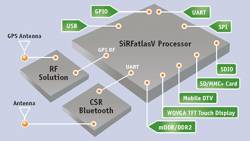
CSR plc. introduced the SiRFstarIV GSD4e GPS location processor, the newest member of the recently launched SiRFstarIV architecture, at the company’s Location 2.0 Summit in San Diego, California, earlier this month.
The GSD4e adds a built-in CPU and innovations such as SiRFGeoRecov technology that are optimized to ensure continuous location awareness in a new breed of digital cameras, portable game consoles, wearable platforms and other consumer devices, without loading the host processor.
CSR plc. introduced the SiRFstarIV GSD4e GPS location processor, the newest member of the recently launched SiRFstarIV architecture, at the company’s Location 2.0 Summit in San Diego, California, earlier this month.
The GSD4e adds a built-in CPU and innovations such as SiRFGeoRecov technology that are optimized to ensure continuous location awareness in a new breed of digital cameras, portable game consoles, wearable platforms and other consumer devices, without loading the host processor.
“Adding the GSD4e to our SiRFstarIV portfolio gives our customers the choice of both plug-in and host-based implementations of our breakthrough location awareness technology for greater flexibility in creating a variety of geo-aware mobile devices,” said Kanwar Chadha, chief marketing officer for CSR and founder of SiRF, which merged with CSR earlier this year.
“And because it has a built-in processor, the GSD4e makes it easy to quickly integrate location awareness into existing platforms, enables development of innovative modules and products with customizable differentiation, and provides our extensive SiRFstarIII customer community with a seamless upgrade path.”
Value-added manufacturers, including Vincotech, Navman Wireless, Kyocera, Mitsumi, and SEMCO, are designing modules with the GSD4e for launch in the fourth quarter of 2009, according to CSR.
A host-based version of the SiRFstarIV — the GSD4t — was introduced in July of this year, targeting mobile phones, mobile computers, and mobile Internet devices
According to CSR, the SiRFstarIV architecture core is comprised of a GPS location engine, “smart” location sensor interface, adaptive micro-power manager, and an active jammer remover that together deliver:
• twice the search capacity of the previous SiRFstarIII architecture, resulting in enhanced sensitivity, reduced time-to-fix and improved positional accuracy
• advanced micro-power management and integrated switched-mode regulation that maintains hot-start conditions with low energy requirements
• intelligent microelectromechanical system (MEMS) sensor support (for accelerometers and other sensors)
• advanced digital signal processor (DSP) technology that actively searches for jammers and removes them prior to correlation for maximum GPS performance and design troubleshooting.
According to CSR, the GSD4e can navigate to -160 dBm and track to -163 dBm. For smartphone customers, the GSD4e offers a 7.5-dB 3GPP pass margin and high E911 sensitivity as well as a fully certified assisted-GPS (A-GPS) protocol stack to ease integration into a variety of smartphone operating systems.
An on-chip active jammer removal is designed to eliminate electrical noise commonly associated with the motors, LCD screens, and other components found in smartphones, cameras, game consoles, and other consumer devices. That feature also helps designers pinpoint much earlier in the development process the precise strength and source of interfering signals, enabling them to be contained in the design phase rather than in later, more costly test phases.
The GSD4e combines RF receiver and integrated LNA, baseband circuitry, switcher, and low-current LDOs on a single chip, and requires only five to six external passive components and a single SAW to provide a complete solution that occupies less than 25 square millimeters, including switcher parts.
The GSD4e reportedly consumes 8 milliwatts in 1-hertz TricklePower mode and can maintain hot-start conditions continuously in SiRFaware mode while drawing as little as 50-400 microamperes. Its enhanced SiRFNavPlus navigation engine is designed to provide seamless car and pedestrian navigation in difficult signal environments, including urban canyons and dense foliage.
Available in both ROM and flash supported versions, the GSD4e is the first CSR product to come with patented SiRFInstantFix synthetic ephemeris technology as a standard feature for even greater performance. The GSD4e also supports a full range of satellite-based augmentation systems, including WAAS, EGNOS, MSAS and GAGAN.
The GSD4e’s adaptive accuracy and SiRFGeoRecov technologies make it possible to instantly geo-tag images or videos with a camera or camcorder and improve accuracy as better GPS information becomes available.
The GSD4e has built-in circuitry and temperature adaptive software that allow it to replace a temperature compensated crystal oscillator (TCXO) with a low-cost crystal. Integrated eFuse technology helps customers design their systems by electronically setting custom configurations at system boot-up instead of more time-consuming manual software changes.
The ROM version measures 3.5 × 3.2 millimeters and comes in a 42-ball, 0.5-millimeter pitch wafer level chip scale (WLCSP) package. The flash version measures 5 × 7.2 millimeters and comes in a 103-ball, 0.5-millimeter pitch ball grid array (BGA) package.
The CSR SiRFstarIV GSD4e single-chip GPS engine with external flash memory is currently available in sample quantities. The ROM version will be available later this quarter. Production quantities are scheduled for the first quarter of 2010.





